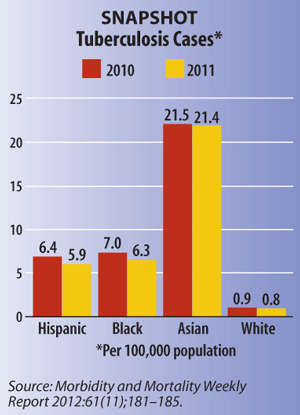The number of new tuberculosis (TB) cases reported in the U.S. last year dropped to the lowest recorded rate in more than 50 years. Despite the disease's decline, new data revealed that the number of cases in people born outside the U.S. continues to rise, showing that racial and ethnic disparities still exist.
For the first time, non-Hispanic Asians surpassed persons of Hispanic ethnicity as the largest racial/ethnic group of TB patients in 2011, according to the report, "Trends in Tuberculosis—United States, 2011." The 2011 TB cases reported to CDC's National Tuberculosis Surveillance System showed that foreign-born persons and racial/ethnic minorities continue to be affected disproportionately.
The report also found that among persons with TB, 95.4% of Asians, 73.9% of Hispanics, 36.4% of blacks, and 20.9% of whites were foreign-born.

The rate of incident TB cases, representing new infection and reactivation of latent infection, among foreign-born persons in the U.S., was 12 times greater than among U.S.-born persons. Compared with non-Hispanic whites, the TB rate among non-Hispanic Asians was 25 times greater, and the rates among non-Hispanic blacks and Hispanics were eight and seven times greater, respectively. Among U.S.-born racial and ethnic groups, the greatest racial disparity in TB rates occurred among non-Hispanic blacks, whose rate was six times the rate for non-Hispanic whites.
TB rates among states showed dramatic differences, from 0.7% in Maine to 9.3% in Alaska. Thirty-four states had lower rates in 2011 than in 2010; 16 states and the District of Columbia had higher rates.
CDC recommends improving awareness, testing, and treatment of latent infection and TB disease in minorities and foreign-born populations as ways to combat TB.
The full report is available online.